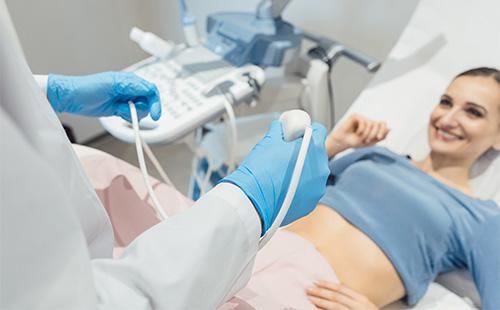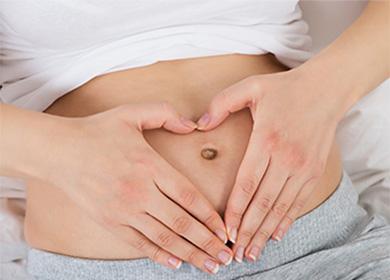The content of the article
What does the saddle uterus mean? In the context, such an organ looks like a saddle for riding and belongs to the subtype of the bicornuate uterus. The bottom is as if split into two parts, but the transition is smooth. Depending on individual characteristics, a woman may not have any symptoms or suffer from algomenorrhea and heavy periods. More often, the anomaly affects the bearing, childbirth and the nature of the postpartum period. Classification according to ICD-10 - Q51.3.
Causes of anomaly
Normally, the female genital organ has the shape of a pear and its narrow side is down. The upper part is the bottom, and the lower communicates with the neck, which serves as a transition into the vagina. The sizes are variable, but on average a woman’s uterus has parameters of 5 × 8 cm, and weight - up to 60 g.
The exact reasons for the appearance of the bicorn (saddle) uterus have not been established, but it is known that the formation of internal genital organs occurs at 10-14 weeks of fetal development. The body of the organ is formed from two cords (Muller ducts), which merge together during gestation. Thus, an integral pear-shaped uterus and neck are formed. At the beginning of embryogenesis, its saddle shape is allowed, but by the birth of the girl, the septum should disappear.
Adverse factors can affect the formation of reproductive organs in the fetus. As a result, the partition does not disappear completely. Most often, this occurs during intoxication of the pregnant woman due to drug addiction, the use of nicotine and alcohol, some unwanted medications, as well as when working in hazardous industries. In addition, they increase the risk of:
- malnutrition (lack of minerals and vitamins);
- stressful situations;
- endocrine system diseases;
- infectious diseases;
- prolonged toxicosis.
Classification
It is noteworthy that uterine bicornism is normally observed in cats and dogs. When palpating a pregnant animal on the sides, the location of the fruits is felt, as in a bean pod. The female genital organ is initially programmed for one child (multiple pregnancy is an exception), but there are several anatomical options for deviations from the norm:
- saddle (arcuate) - the inner cavity is almost not deformed, there is a recess in the bottom, there may be a septum (often incomplete);
- bicorn with incomplete septum - the cavity is divided into two parts that communicate in the neck region, the “saddle” in the bottom region is very pronounced, the height of the partition can be different;
- bicorn with a full partition - the partition divides the cavity into two parts, there is no message, the neck is one or two (split);
- full doubling- two full uterus and cervix;
- complete or partial hypoplasia- infantile (underdeveloped) uterus or in the form of a cord.
Manifestations before and during pregnancy
According to examination and even pelvic ultrasound, it is difficult to identify an anomaly. Characteristic symptoms:
- before conception - heavy and painful menstruation, prolonged daub in the last days of menstruation, pain during sex, the uterus is not suitable;
- when carrying - the threat of miscarriage and missed pregnancy, abnormal placenta, improper presentation of the fetus, premature detachment of the placenta, bleeding during childbirth and the postpartum period, abnormal labor.
Often, pregnancy in women with a saddle-shaped uterus occurs without any deviations, but with established anomalies, delivery by cesarean section may be recommended (due to the high frequency of complications during natural childbirth). The approach is individual.
Infertility risk
This anomaly is not a factor of infertility, and the position for conception does not matter. If pregnancy does not occur, other causes should be identified. The exception is when combined with the septum of the uterus, and also if it is difficult to diagnose with bicorn.
Pregnancy in most cases proceeds without features, problems arise during gestation and childbirth. This is due to the increased excitability of the organ, inadequate responses to stimulation of contractions during childbirth, and abnormal contractility. All this leads to discoordination and weakness of labor, postpartum hemorrhage. For this reason, the likelihood of a cesarean section is increasing, and the saddle organ is a “find” and “answer to all questions” during surgery.

Diagnostics
What does diagnosis mean and how does this happen? Diagnosis of anomalies in the development of an organ is carried out using the following methods.
- Ultrasound procedure. Ultrasound is preferably performed in the second half of the menstrual cycle. At this time, the endometrium is maximally thickened, it is precisely by its nature that one can trace the organ cavity and draw a conclusion about saddle shape.
- Hysterography. A method in which a radiopaque substance is introduced into an organ cavity, and then pictures are taken. They will notice a deepening in the bottom, protruding into the uterine cavity. The contour of the cavity takes the form of a "heart". In the presence of a septum, an abnormal distribution of contrast is additionally detected.
- MRI and CT. Methods of magnetic resonance or computed tomography allow you to study in detail the structure of the internal genital organs.
- Hysteroscopy. At the same time, a special optical sensor is introduced into the organ cavity through the cervical canal, allowing you to examine the endometrium from the inside. This method is the most effective. During hysteroscopy, you can also remove some options for partitions. Among the contraindications for this procedure are pelvic inflammatory disease, acute infectious diseases, thrombophlebitis, liver and heart pathologies, as well as uterine and ectopic pregnancy.
Treatment
If the anomaly is asymptomatic, treatment is not required. Pain during menstruation or sexual intercourse is stopped by the use of analgesics, spasmalgetics. With heavy menstruation, the use of hormonal contraceptives or hemostatic tablets is possible.
If there are pathologies of gestation, the treatment is symptomatic and is aimed at preserving the child. It is impossible to affect the location of the placenta or fetus.
Surgical intervention is necessary in the following cases:
- the anomaly "borders" on two-hornedness;
- anomaly with a septum;
- habitual miscarriage due to uterine pathology.
If there is a septum, hysteroscopy can be performed to excise it. But in the case of its large size and muscle consistency, preference is given to abdominal surgery. If it is necessary to correct the shape of the organ, reconstructive surgery with laparotomy access is performed. We are not talking about laparoscopy.
Reviews
I have such a shape of the uterus and my mother gave birth to her, nothing. I do not have Children, but I had many miscarriages against this background, which is very sad. I'm afraid that it will never work out.
Mary https://deti.mail.ru/forum/v_ozhidanii_chuda/planirovanie_beremennosti/sedlovidnaja_matka_1390376760/
I also have a saddle uterus, in November I gave birth to 3 children and the pregnancy was calm even with a discount on my age (36 years) so do not worry, everything will be OK
stella_di_mare, https://deti.mail.ru/forum/v_ozhidanii_chuda/planirovanie_beremennosti/sedlovidnaja_matka_1390376760/
I have such a diagnosis. She endured and gave birth normally at 30. This diagnosis was not voiced at all and was not taken into account by anyone during pregnancy. Only immediately after birth did the doctor feel with her hands and ask if there was any pathology. I said that the saddle uterus. Well, that’s it.
Katya’s mother, http://www.woman.ru/health/woman-health/thread/4313420/
I also have a saddle uterus. I transferred the first week, and the second was born 4 days earlier. The weight of children is 3900 and 3700 kg. Gave birth herself. Initially, they scared what Caesarean would do.
Katya, http://www.woman.ru/health/woman-health/thread/4313420/

